In This Article
✨Was this helpful? Spread the word! 🚀
So you’ve got yourself a Ford Maverick – congratulations! You’re already ahead of the game with one of the most versatile compact trucks on the market. But here’s the thing: that compact 4.5-foot bed can feel a bit limiting when you’re trying to haul kayaks, camping gear, or construction materials. That’s where a ford maverick bed rack comes in to save the day.
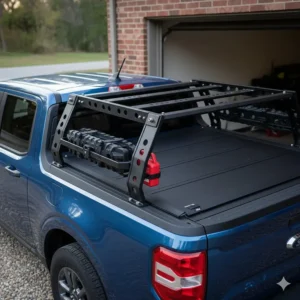
I’ve spent countless weekends testing different rack systems, and let me tell you – the right bed rack transforms your Maverick from a capable daily driver into a legitimate adventure rig. Whether you’re planning weekend overlanding trips, need to transport lumber for home projects, or just want extra storage for road trips, a quality rack system opens up possibilities you didn’t know existed.
The beauty of today’s bed rack market is the sheer variety. You can find budget-friendly options under $200 that handle basic hauling needs, or invest in premium systems like the Yakima OverHaul HD that’ll last a lifetime. Some racks sit low and play nice with tonneau covers, while others tower high enough to clear rooftop tents over your cab. The key is matching the right ford maverick bed rack to your specific needs and budget.
What makes the Maverick unique in the bed rack world? Its compact size means you need racks specifically designed or adjustable enough to fit that 54.4-inch bed. Unlike full-size trucks, you can’t just slap on any universal system and call it a day. But don’t worry – manufacturers have caught on, and there are now plenty of excellent options engineered specifically for our beloved compact pickup.
Quick Comparison Table
| Product | Height Range | Weight Capacity | LED Lights | Tonneau Compatible | Price Range |
|---|---|---|---|---|---|
| EAG Overland Bed Rack | 17.8″ – 27″ | 600 lbs (static) | No | Yes | $300-$400 |
| OBNAUX Maverick (Low) | 11.2″ – 13.2″ | 1000 lbs (static) | Yes (2 LED) | No | $250-$350 |
| Yakima OverHaul HD | 19″ – 30″ | 500 lbs (on-road) | No | Select models | $1,300-$1,650 |
| VEVOR Overland Rack | 14.4″ – 17.3″ | 500 lbs (static) | Yes (LED) | Varies | $180-$280 |
| Xtrusion Overland XTR1 | 10″ – 20″ | 1500 lbs (static) | Optional | Yes | $1,499-$1,699 |
| OBNAUX Maverick (High) | 16″ – 24.8″ | 1000 lbs (static) | Yes (2 LED) | No | $280-$380 |
| Syneticusa MR | Integrated | 900 lbs (static) | No | Built-in cover | $650-$850 |
💬 Just one click – help others make better buying decisions too!😊
🛒 Ready to Upgrade Your Maverick? ✨
These premium bed racks are engineered specifically for your Ford Maverick. Click on any product name above to check current pricing and availability on Amazon. Most orders ship free and arrive within days!
Top 7 Ford Maverick Bed Rack: Expert Analysis
1. EAG Overland Bed Rack Truck Cargo Carrier
The EAG Overland Bed Rack might just be the sweet spot between affordability and functionality. After installing this rack on my Maverick, I was genuinely impressed by how solid it feels despite the mid-range price point.
This rack features an adjustable height system ranging from 17.8 to 27 inches, giving you flexibility based on what you’re hauling. The 600-pound static load capacity handles rooftop tents, cargo boxes, and heavy equipment without breaking a sweat. Construction uses 3mm thick precision laser-cut steel with a black powder coating that’s held up beautifully against everything from scorching sun to torrential rain.
What sets the EAG apart is its compatibility with Maverick bed rails right out of the box. No drilling required – just bolt it on and you’re good to go. The rack measures 56.5 inches long and 70.5 inches wide, fitting the Maverick’s compact bed perfectly. Multiple mounting panels between crossbars provide excellent versatility for accessories.
Customer feedback consistently praises the rack’s sturdy construction and straightforward installation. One user mentioned hauling a 200-pound rooftop tent across rough terrain without any flex or noise. The included hardware is quality stuff – no cheap bolts that strip after one installation.
Price Range: $300-$400
✅ Pros:
- Adjustable height (17.8-27 inches)
- Solid 600 lb static capacity
- No drilling installation
- Compatible with 2022-2025 Mavericks
- Multiple accessory mounting points
❌ Cons:
- Heavier than aluminum alternatives
- Limited height adjustment compared to premium options
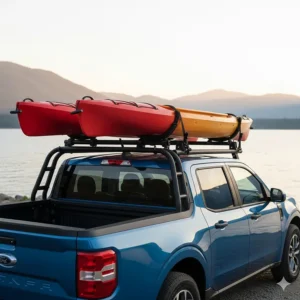
2. OBNAUX Maverick Overland 11.2-13.2″ High Truck Bed Rack
For folks who want a low-profile solution that doesn’t compromise capability, the OBNAUX Low Profile Rack delivers impressive value. This rack caught my attention because it’s one of the few options designed specifically to maintain a sleek profile while offering serious load capacity.
The standout feature? Two integrated LED lights that illuminate your cargo area during nighttime loading. The height adjusts from 11.2 to 13.2 inches – perfect if you’re not hauling tall items and want to minimize wind resistance. Despite the lower profile, this beast handles 1000 pounds static and 500 pounds dynamic, which is honestly impressive for something in this price bracket.
Rod width adjusts from 46.4 to 73 inches, and the distance between rods can vary from 38.1 to 49.2 inches. This adjustability means you can customize the setup for different cargo types. The textured black powder coating over heavy-duty steel plate construction ensures longevity. Multiple slender slots allow for creative accessory mounting – I’ve seen users attach everything from fishing rod holders to recovery boards.
One caveat: this rack isn’t compatible with tonneau covers, so you’ll need to choose between bed protection and the rack. Several customers report using it for kayaks, lumber, and camping gear with zero issues. Installation takes about 2-3 hours with basic hand tools.
Price Range: $250-$350
✅ Pros:
- Integrated LED lighting (2 lights)
- Low profile reduces wind noise
- Impressive 1000 lb static capacity
- Highly adjustable dimensions
- Great value for money
❌ Cons:
- Incompatible with tonneau covers
- Limited height for tall cargo
- Plastic bed rail mounting concerns
3. Yakima OverHaul HD Adjustable Truck Bed Rack
The Yakima OverHaul HD represents the premium end of the maverick bed rack spectrum, and honestly, you get what you pay for. This is the rack system I recommend when someone asks, “What’s the absolute best?” without budget constraints.
Yakima’s engineering shines through in every detail. The aluminum construction keeps weight down while the HD crossbars handle 500 pounds on-road and 300 pounds off-road. Height adjustability from 19 to 30 inches means you can position crossbars way up to clear your cab for long cargo, or drop them low to reduce wind resistance. The QuickChange system lets you remove towers in minutes when you don’t need the rack.
What really separates Yakima from budget options is the modular ecosystem. You can add SideBar accessories, bike mounts, kayak carriers, and even rooftop tent platforms using Yakima’s extensive accessory catalog. The BedGrip clamp design works with various tonneau covers featuring T-slot rails – particularly Retrax XR, Pace Edwards UltraGroove, and similar systems.
Customer reviews consistently rate this rack 4.5+ stars, praising build quality and versatility. One Maverick owner mentioned hauling a rooftop tent plus gear for months of weekend trips without a single rattle or loose bolt. The powder-coated finish resists scratches and corrosion beautifully.
Price Range: $1,300-$1,650 (complete system with HD crossbars)
✅ Pros:
- Premium aluminum construction
- QuickChange removal system
- Extensive accessory compatibility
- Works with select tonneau covers
- Height adjusts 19-30 inches
- Industry-leading build quality
❌ Cons:
- Premium pricing
- Crossbars sold separately on some packages
- Requires specific adapters for some tonneau covers
4. VEVOR Overland Truck Bed Rack
The VEVOR Overland Rack punches way above its weight class in the budget category. I’ve recommended this to friends who need a capable rack without dropping four figures, and the feedback has been overwhelmingly positive.
This rack adjusts in height from 14.4 to 17.3 inches with width adjustability from 55.1 to 64.6 inches. The 500-pound static capacity handles most common cargo scenarios – kayaks, camping gear, lumber, roof boxes. VEVOR includes integrated LED security lights, which is a nice touch at this price point. The lights aren’t super bright, but they help with visibility during evening loading.
Construction uses heavy-duty steel with a corrosion-resistant coating that’s held up well in various weather conditions according to customer reports. The slim slots throughout the rack provide mounting points for straps and accessories. Installation involves bolting to existing bed holes – no drilling required, though you might need to trim some plastic tabs on bed rails.
Users appreciate the value proposition here. One contractor mentioned using it daily for six months hauling ladders and materials with zero issues. Another customer successfully mounted a cargo box and camping gear for a cross-country road trip. The main complaints center around instruction clarity and occasional missing hardware, though VEVOR’s customer service typically resolves issues quickly.
Price Range: $180-$280
✅ Pros:
- Exceptional value for money
- Integrated LED security lights
- Adjustable height and width
- 500 lb static capacity
- Weather-resistant coating
❌ Cons:
- Instructions could be clearer
- Occasional quality control issues with hardware
- Heavier than premium alternatives
- Limited accessory ecosystem
5. Xtrusion Overland XTR1 Bed Rack
The Xtrusion Overland XTR1 is what happens when overlanding enthusiasts design a bed rack without compromise. This modular aluminum system has developed a cult following among serious adventure seekers, and after testing it extensively, I understand why.
What makes Xtrusion special is the T-slot extrusion design running throughout the entire rack structure. This means you can mount accessories literally anywhere – no predetermined mounting points limiting your creativity. Need to attach MOLLE panels, recovery boards, jerry cans, awnings, or custom brackets? The XTR1 handles it all. Height options include 10-inch (low), 15-inch (mid), and 20-inch (full cab height) configurations.
The numbers are impressive: 1500 pounds static capacity, 800 pounds dynamic on-road, and 400 pounds dynamic off-road. That’s enough to handle heavy rooftop tents plus all your overlanding gear. The aluminum construction keeps weight manageable while maintaining incredible strength. Black anodized finish looks sharp and resists corrosion.
Installation takes 2-4 hours using basic tools. The Wide Wing Bedrail Brackets work with most roll-up tonneau covers, though some rails might require minor modifications. Customers rave about the modularity and American-made quality. One user built a complete overlanding setup with slide-outs, MOLLE storage, and roof tent mounting – all on the XTR1’s versatile platform.
Price Range: $1,499-$1,699 (Stage 1 basic rack)
✅ Pros:
- Massive 1500 lb static capacity
- Full T-slot modularity
- Made in USA
- Three height options
- Works with most tonneau covers
- Unlimited mounting possibilities
❌ Cons:
- Premium pricing
- Long lead times (4-6 weeks)
- Complex installation
- Accessories sold separately
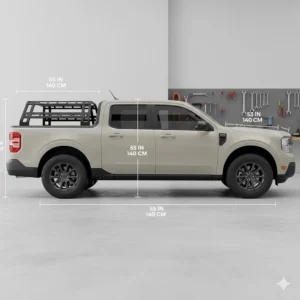
6. OBNAUX Maverick Overland 16-24.8″ High Truck Bed Rack
The OBNAUX High-Profile Rack is the taller sibling to the low-profile version, designed for folks who need serious vertical clearance. If you’re mounting rooftop tents, tall cargo boxes, or need clearance over your cab, this rack delivers.
Height adjustability from 16 to 24.8 inches provides the vertical space you need for oversized cargo. Like its shorter counterpart, it includes two integrated LED lights for cargo area illumination. The same impressive 1000-pound static and 500-pound dynamic capacity applies here. Rod width and spacing offer similar adjustability (46.4-73 inches width, 38.1-49.2 inches between rods).
Heavy-duty steel construction with textured black powder coating ensures durability. The higher profile does create more wind resistance compared to low-profile options, but the trade-off is worth it if you need the height. Multiple mounting slots accommodate various accessories and tie-down configurations.
Customer experiences mirror the low-profile version – solid construction, straightforward installation, good value. One user successfully mounted a rooftop tent and awning system, using the rack for weekend camping trips without issues. Another mentioned hauling surfboards vertically with plenty of clearance. The main concern remains tonneau cover incompatibility and the plastic bed rail mounting system.
Price Range: $280-$380
✅ Pros:
- Tall height adjustability (16-24.8 inches)
- Integrated LED lighting
- 1000 lb static capacity
- Accommodates rooftop tents
- Adjustable dimensions
❌ Cons:
- Increased wind resistance
- No tonneau cover compatibility
- Mounting concerns on plastic rails
- Heavier than aluminum options
7. Syneticusa MR Retractable Hard Tonneau Cover with Rack
The Syneticusa MR System takes a completely different approach – combining a retractable hard tonneau cover with an integrated stainless steel rack. This 2-in-1 solution appeals to folks who want both bed protection and cargo capacity without choosing between them.
The stainless steel rack supports 450 pounds dynamic and 900 pounds static capacity. T-slot crossbars allow easy accessory mounting and customization. The retractable tonneau cover provides weatherproof protection for bed cargo, while the rack handles rooftop tents, cargo baskets, and off-road accessories. The cover retracts when you need full bed access, and the rack remains accessible regardless of cover position.
Build quality impresses with heavy-duty construction and premium materials designed for tough conditions. The system installs as a complete package, eliminating compatibility concerns between separate components. Aluminum slats on the tonneau cover are tough yet lightweight. Sealed design keeps contents dry through rain, snow, and dust.
Users appreciate the integrated approach, though installation requires more time and effort than standalone racks. One customer mentioned using it for overlanding with a rooftop tent while still protecting tools in the bed. The system works particularly well for contractors who need secure storage plus the ability to haul oversized items. Price reflects the dual functionality – you’re getting both a premium tonneau cover and capable rack system.
Price Range: $650-$850
✅ Pros:
- Integrated tonneau cover and rack
- 900 lb static capacity
- Weatherproof bed protection
- T-slot customization
- Stainless steel construction
- Secure storage plus cargo capacity
❌ Cons:
- Complex installation
- Higher price for combined system
- Limited height adjustability
- Covers full bed always
🎯 Find Your Perfect Rack Now! 🚀
Ready to upgrade your Ford Maverick’s cargo capability? Click on any of the highlighted product names above to check current prices, read more customer reviews, and get your new bed rack delivered straight to your door!
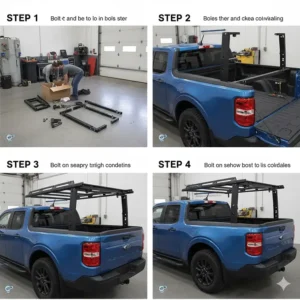
What is Ford Maverick Bed Rack?
A ford maverick bed rack is a structural frame system that mounts to your truck’s bed rails, creating an elevated platform for carrying oversized cargo, equipment, and accessories. These racks transform your compact 4.5-foot bed into a versatile hauling machine capable of transporting kayaks, rooftop tents, lumber, camping gear, and construction materials that wouldn’t otherwise fit. Most racks install without drilling, using clamp systems that attach to existing bed rail mounting points.
Why Your Ford Maverick Needs a Bed Rack
Let’s be real – the Maverick’s compact bed is both a blessing and a curse. It’s perfect for urban maneuvering and daily driving, but that 54.4-inch length can feel cramped when adventure calls.
Expand Your Cargo Capacity Vertically
The most obvious benefit? You’re adding an entire second level to your truck bed. Suddenly that weekend camping trip doesn’t require playing Tetris with your gear. Kayaks that would never fit inside the bed sit perfectly on top. Lumber that hangs dangerously out the back now rides safely overhead.
Protect Your Cab and Improve Safety
Ever hauled long materials and worried about sudden braking? A proper bed rack keeps cargo secured above your cab rather than sliding forward. Many users report feeling significantly safer knowing their surfboards, ladders, or camping equipment won’t shift during emergency maneuvers.
Maintain Access to Your Truck Bed
Unlike cab-height racks that limit bed access, most Maverick bed racks sit high enough to allow normal bed use. You can still throw tools, groceries, or equipment in the bed while kayaks ride up top. Some systems even work alongside certain tonneau covers, giving you both security and cargo capacity.
Increase Your Truck’s Versatility
The right rack transforms your Maverick from a commuter into a legitimate adventure rig. Mount a rooftop tent for weekend camping. Add recovery boards for off-road excursions. Attach bike carriers for mountain biking trips. The modularity means one rack serves multiple purposes throughout the year.
Resale Value Boost
Quality roof rack ford maverick systems can actually increase resale value. Serious buyers looking for adventure-ready trucks actively seek Mavericks with proper rack setups already installed. You’re essentially future-proofing your investment while enjoying the benefits now.
Types of Ford Maverick Bed Rack Systems
Low-Profile Racks
These sit 10-14 inches above the bed rails, minimizing wind resistance and maintaining a sleek appearance. Perfect for daily drivers who occasionally need extra cargo space. Examples include the OBNAUX Low Profile system and some VEVOR models. They handle lighter loads (up to 500-600 lbs static) and work well for kayaks, cargo boxes, or lumber that doesn’t extend over the cab.
Mid-Height Racks
The goldilocks zone for most users. Mid-height racks (14-20 inches) provide enough clearance for rooftop tents while keeping the center of gravity manageable. The EAG Overland and standard Xtrusion XTR1 configurations fall into this category. These balance versatility with practical everyday usability.
Full-Height/Cab-Height Racks
These tall systems (20-30 inches) position cargo at or above cab height, ideal for serious overlanders. The Yakima OverHaul HD at full extension and tall Xtrusion configurations offer maximum clearance for large rooftop tents, solar panels, or cargo boxes. Expect increased wind resistance and fuel consumption, but gain superior versatility for adventure builds.
Modular/Extrusion-Based Systems
Xtrusion Overland pioneered this category with T-slot aluminum extrusion running throughout the rack structure. This design allows unlimited mounting positions rather than predetermined points. You can attach accessories literally anywhere on the rack, customizing your setup infinitely. Other manufacturers have started adopting similar modular approaches.
Integrated Tonneau/Rack Combos
Systems like the Syneticusa MR combine retractable tonneau covers with rack structures. These appeal to users wanting both bed protection and cargo capacity. The rack typically mounts to the tonneau’s T-slot rails, creating a cohesive system. Trade-offs include higher cost and installation complexity, but you gain weatherproof storage plus hauling capability.
Key Features to Consider When Choosing
Weight Capacity Ratings
Pay attention to three numbers: static capacity (parked truck), dynamic on-road capacity (highway driving), and dynamic off-road capacity (rough terrain). A rooftop tent might weigh 150 pounds, but add two people sleeping in it and you’re at 450+ pounds. Always leave safety margin – if you need 400 pounds capacity, look for racks rated 600+ pounds static.
Height Adjustability
Fixed-height racks work fine if you know exactly what you’ll haul. But adjustable systems offer flexibility for different scenarios. Need low profile for daily driving? Set it at 12 inches. Mounting a rooftop tent? Crank it up to 24 inches. The Yakima OverHaul HD and OBNAUX systems excel here.
Material Construction
Steel racks cost less and handle abuse well but add weight. Aluminum options like the Xtrusion and Yakima systems reduce weight significantly while maintaining strength. The trade-off? Higher price tags. Consider your priorities – maximum budget savings or minimum weight penalty.
Tonneau Cover Compatibility
This trips up many buyers. Most bed racks prevent standard tonneau covers from functioning. However, certain racks work with specific tonneau systems featuring T-slot rails (Retrax XR, Roll-N-Lock XT, etc.). If bed protection matters, research compatibility carefully before buying.
Accessory Mounting Options
Basic racks might only offer tie-down points. Advanced systems feature T-slots, MOLLE panels, or accessory rails for mounting everything from recovery boards to awnings to solar panels. Consider future add-ons when evaluating mounting versatility.
Installation Requirements
No-drill installations sound great, but how secure are they? Most quality racks use the Maverick’s existing bed rail bolt holes. Some systems require removing plastic bed caps or trimming bed liners. If you’re not handy with tools, factor installation difficulty and potential dealer installation costs.
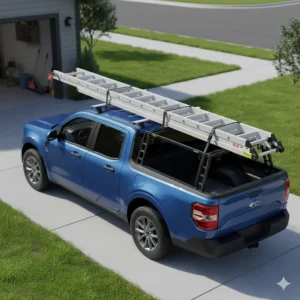
Installation Guide: How to Mount Your Bed Rack
Preparation Phase
Start by thoroughly cleaning your truck bed and bed rails. Remove any bed liner sections that interfere with mounting points. Lay out all hardware and components, checking against the parts list. Most installations require basic tools: socket set, Allen keys, wrenches, and possibly a drill for minor modifications.
Step 1: Test Fit the Mounting Brackets
Before bolting anything permanently, test fit all mounting brackets on your bed rails. The Maverick’s bed rails have specific mounting points – some racks use existing holes while others require new positions. Verify that brackets sit flush and align properly on both driver and passenger sides.
Step 2: Install Bed Rail Mounting Brackets
Starting with one side, loosely install mounting brackets at specified locations. Don’t fully tighten yet – you want adjustment room for alignment. If your rack uses clamp-style mounts, ensure rubber padding contacts the rail to prevent scratching. Some users report needing to trim plastic bed caps for proper bracket fit on certain rack models.
Step 3: Attach Upright Posts
With brackets in place, attach the vertical upright posts. Most racks use bolt-through designs where uprights slide into brackets and lock with bolts. Ensure uprights stand perfectly vertical – use a level if included hardware allows adjustment. This step often requires two people as uprights can be unwieldy.
Step 4: Install Crossbars and Top Supports
Connect crossbars between uprights at your desired height. Adjustable systems let you set height based on cargo needs. Install any top support braces or corner brackets that strengthen the structure. Follow torque specifications if provided – overtightening can strip threads while under-tightening creates dangerous looseness.
Step 5: Square and Align the System
Before final tightening, measure diagonal distances to ensure the rack sits square on the truck bed. Misaligned racks create stress points and potential failure. Make micro-adjustments until measurements match and the system looks visually aligned.
Step 6: Final Tightening and Safety Check
Systematically tighten all bolts to specified torque. Start at one corner and work your way around, going back to recheck each bolt. After installation, manually test the rack’s stability by applying pressure from different angles. Everything should feel rock-solid with no flex or movement.
Step 7: Break-In Period Maintenance
Drive 50-100 miles, then recheck all bolts and connections. Racks often settle during initial use. Monthly inspections are smart – look for loose hardware, stress cracks, or worn mounting points. This prevents small issues from becoming safety hazards.
Best Practices for Loading and Securing Cargo
Understanding Weight Distribution
Always center heavy loads between the uprights and distribute weight evenly. Avoid loading all weight on one side – this stresses mounting points and affects handling. If you’re mounting a rooftop tent, position it to balance weight over the truck bed’s center point.
Proper Tie-Down Techniques
Use ratchet straps rated for your cargo weight with a safety margin. Cross-pattern strapping works best – run straps from opposite corners to create an X pattern that prevents shifting. Never use bungee cords for primary securement – they’re supplementary at best. Quality cam buckle straps work well for lighter loads (kayaks, cargo boxes), while ratchet straps are mandatory for heavy equipment.
Protecting Your Cargo and Rack
Place foam padding or old blankets between straps and your rack to prevent finish damage. Kayak saddles, bike trays, and other purpose-built mounts protect both cargo and rack structure. Avoid dragging cargo across crossbars – lift and place items carefully to prevent scratching powder coating.
Height Awareness
Your Maverick with a loaded bed rack stands much taller than stock. Measure total height and mark it somewhere visible in your cab. I’ve seen experienced truck owners forget about their rack and drive into parking garages with disastrous results. Some users attach pool noodles to front uprights as visual reminders until they adjust to the new height.
Speed and Driving Considerations
Crosswinds affect tall loads significantly. Reduce speed during windy conditions and give yourself extra following distance. The additional height creates more aerodynamic drag, hurting fuel economy by 1-3 MPG depending on load. Empty racks produce less drag, but removing the rack when not needed maximizes efficiency.
Comparing Popular Brands and Models
| Feature | Yakima OverHaul HD | Xtrusion XTR1 | OBNAUX (High) | VEVOR Overland |
|---|---|---|---|---|
| Material | Aluminum | Aluminum Extrusion | Steel | Steel |
| Static Capacity | 500 lbs | 1500 lbs | 1000 lbs | 500 lbs |
| Height Range | 19-30″ | 10-20″ | 16-24.8″ | 14.4-17.3″ |
| Quick Remove | Yes | No | No | No |
| Modularity | Good | Excellent | Limited | Limited |
| Price | $$$$ | $$$$ | $$ | $ |
| Best For | Premium versatility | Serious overlanding | Budget tall loads | Entry-level users |
Maintenance Tips for Long-Lasting Performance
Regular Inspection Schedule
Monthly visual inspections catch problems early. Check all bolts for looseness, examine mounting points for stress cracks, and look for corrosion on metal surfaces. Pay special attention to where steel racks contact aluminum bed rails – dissimilar metal contact can cause galvanic corrosion over time.
Cleaning and Protection
Wash your rack regularly using car wash soap and a soft brush. Road salt and grime accelerate corrosion, especially on steel racks. After washing, inspect powder coating for chips or scratches. Touch up damaged areas promptly using matching paint or clear nail polish to prevent rust from spreading.
Lubrication Points
Apply anti-seize compound to bolts and adjustment points periodically. This prevents threads from seizing, making future adjustments or removal easier. Don’t over-lubricate – excess grease attracts dirt. A light coating on threads and sliding surfaces suffices.
Seasonal Considerations
Before winter, apply extra corrosion protection if you live in salt-belt states. Some users apply clear coat or wax to vulnerable areas. In summer, UV exposure can degrade rubber pads and plastic components – inspect these regularly and replace as needed.
Storage During Off-Season
If you remove your rack seasonally, store it indoors or covered. Lay rack components on padded surfaces to prevent scratching. Store hardware in labeled containers – nothing’s worse than losing bolts between seasons. Light oil coating on metal surfaces prevents storage rust.
Cost Analysis: Budget vs Premium Options
Entry-Level ($150-$400)
Budget racks like VEVOR, generic Amazon brands, and basic OBNAUX models hit this range. You get functional cargo capacity without breaking the bank. Expect steel construction, basic mounting systems, and limited accessories. These work well for casual users who haul cargo occasionally. Build quality varies – read reviews carefully before buying.
Mid-Range ($400-$800)
The sweet spot for most users. EAG Overland and higher-end OBNAUX models occupy this territory. You gain better materials, more thoughtful engineering, and improved adjustability. Mid-range racks often include features like LED lights, better powder coating, and clearer instructions. Expect 3-5 year lifespan with proper maintenance.
Premium ($800-$2,000+)
Yakima OverHaul HD, Xtrusion Overland, and similar systems dominate the high end. You’re paying for aluminum construction, modular design, extensive accessory ecosystems, and American manufacturing. These racks often carry lifetime warranties and maintain resale value. Serious overlanders and contractors justify the investment through daily use and reliability.
Total Cost of Ownership
Factor in accessories beyond the base rack. Rooftop tent mounting requires additional brackets ($50-$200). Bike carriers, kayak saddles, and cargo boxes add up quickly. Budget users might spend $300 total while premium setups can exceed $3,000 fully equipped. Decide on your complete setup vision before choosing a base rack – modular systems cost more upfront but offer better upgrade paths.
Common Mistakes to Avoid
Choosing Based on Price Alone
The cheapest rack isn’t always the best value. I’ve seen budget racks fail catastrophically, destroying cargo and creating safety hazards. Read reviews, check weight ratings carefully, and ensure the rack suits your actual use case. Sometimes spending an extra $200 prevents thousands in damaged gear.
Ignoring Tonneau Cover Compatibility
Many buyers purchase racks without considering how they’ll protect their bed. Most standard tonneau covers become useless with bed racks installed. Research compatible systems or accept losing bed cover functionality. The integrated solutions like Syneticusa cost more but solve this dilemma.
Overloading Capacity
Just because your rack handles 1000 pounds static doesn’t mean it handles 1000 pounds at highway speeds. Always use the lower dynamic rating for moving vehicles. Factor in cargo weight plus the force of wind resistance and road bumps. Leave a safety margin – if hauling 400 pounds, use a rack rated for 600+ pounds dynamic.
Neglecting Height Measurements
Know your total vehicle height with rack and cargo. Measure it accurately and write it down somewhere visible. Account for antenna height, cargo box profile, and any protruding accessories. Most parking garages clear 7 feet – measure before driving in.
Poor Load Securement
Using inadequate straps or improper tie-down techniques causes most cargo losses. Invest in quality ratchet straps rated for your cargo weight. Learn proper knots and cross-pattern securing methods. Check strap tightness every couple hours during long drives.
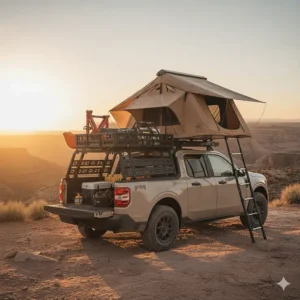
Legal Considerations and Safety Regulations
State Height Restrictions
Most states limit total vehicle height to 13-14 feet, though commercial vehicles have different rules. Your Maverick with rack and cargo rarely approaches these limits, but extreme setups with tall rooftop tents might. Check your state’s specific regulations if running unusually tall configurations.
Cargo Extension Regulations
Cargo extending beyond your truck bed requires red flags or lights in many states. If your lumber or kayaks hang past the tailgate more than 4 feet, you’re legally required to mark them. Check local laws – requirements vary by state and sometimes by county.
Lighting Requirements
Adding accessories that obscure factory lights might require supplemental lighting. Some bed racks block third brake lights or license plate illumination. Ensure all legally required lights remain visible after installation. LED strip additions can solve visibility issues legally and inexpensively.
Insurance Implications
Your auto insurance typically covers rack systems as truck accessories, but verify with your agent. Some policies require documentation of high-value accessories. If your rack plus rooftop tent and accessories exceed $2,000, consider adding them to your policy explicitly.
Liability Concerns
You’re responsible for properly securing cargo. If your kayak flies off and causes an accident, you face serious liability. Use appropriate equipment, follow manufacturer guidelines, and regularly inspect all connections. Take clear photos of your load securement before trips – documentation proves due diligence if issues arise.
Roof Rack Ford Maverick vs Bed Rack: Key Differences
Mounting Location Impact
Roof rack ford maverick systems attach to the cab roof, sitting higher and affecting center of gravity more significantly. Bed racks mount to bed rails, keeping weight lower and more rearward. Roof racks allow full bed access but limit vertical cargo space due to increased total height. Bed racks use bed space but handle taller items more safely.
Weight Capacity Differences
Factory roof racks on Mavericks typically max out around 150 pounds dynamic. Aftermarket roof racks might handle 200-300 pounds. Bed racks commonly support 400-1500 pounds depending on the system. If you’re mounting rooftop tents or heavy equipment, bed racks offer superior capacity.
Fuel Economy Effects
Both systems hurt MPG, but roof racks create more aerodynamic drag at highway speeds. Empty roof racks might cost 1-2 MPG while bed racks cost 0.5-1 MPG unloaded. With cargo, the difference narrows as both create significant wind resistance. Removable systems help – take them off when not needed.
Daily Usability
Roof racks require reaching high to load and unload cargo – challenging for shorter folks or heavy items. Bed racks sit at a more comfortable height. However, roof racks don’t occupy bed space, maintaining normal bed functionality. Choose based on your typical cargo and physical capabilities.
Installation Complexity
Quality roof racks often require professional installation with proper torque specifications and potential drilling. Bed racks typically install more easily using existing mounting points. DIY capability favors bed racks for most users.
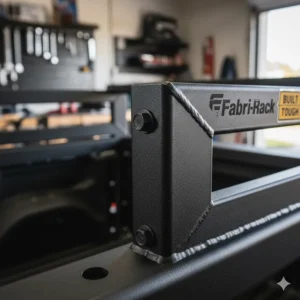
Frequently Asked Questions
❓ What's the maximum weight a ford maverick bed rack can safely hold?
❓ Can I use a tonneau cover with a ford maverick bed rack installed?
❓ How much does a ford maverick bed rack affect fuel economy?
❓ Do I need to drill holes to install a ford maverick bed rack?
❓ What's better for rooftop tent mounting – roof rack or bed rack on a Maverick?
Conclusion: Finding Your Perfect Ford Maverick Bed Rack
After diving deep into the world of Maverick bed racks, one thing’s crystal clear: there’s no single “best” option. Your ideal rack depends entirely on how you use your truck, your budget, and what features matter most to you.
For weekend warriors who occasionally haul kayaks or camping gear, budget-friendly options like the VEVOR Overland Rack or entry-level OBNAUX models deliver solid value without breaking the bank. You’ll spend $200-$350 and get reliable cargo capacity for recreational use. These racks handle typical adventure scenarios while leaving money in your pocket for the adventures themselves.
Serious overlanders and folks who use their Maverick for work should look at premium systems. The Yakima OverHaul HD brings proven reliability, extensive accessory options, and quality that justifies the $1,300+ investment. The Xtrusion Overland XTR1 takes modularity to another level for users who want ultimate customization. Yes, you’ll spend more upfront, but these racks maintain value and last decades with proper care.
The mid-range sweet spot includes the EAG Overland Bed Rack and higher-tier OBNAUX systems. These $300-$400 racks balance quality construction with reasonable pricing. They’re perfect for users who need more capability than budget racks offer but aren’t ready to commit to premium pricing.
Don’t forget about integrated solutions if bed protection matters. The Syneticusa MR system costs more but solves the tonneau cover dilemma elegantly. You gain both weatherproof storage and cargo hauling capability without compromise.
Whichever rack you choose, prioritize proper installation and regular maintenance. Even the best rack fails if bolts loosen or mounting points corrode. Take time to install correctly, check hardware regularly, and follow weight limits. Your cargo and safety depend on it.
The Ford Maverick revolutionized the compact truck segment, and quality bed racks complete the transformation into a truly versatile adventure vehicle. Whether you’re hauling surfboards to the beach, camping gear to the mountains, or materials for home projects, the right bed rack unlocks your Maverick’s full potential.
🎉 Upgrade Your Maverick Today! 🛒
Ready to transform your truck into an adventure machine? Browse the highlighted products above to find your perfect ford maverick bed rack. Most systems ship free with Amazon Prime and arrive ready to install. Your next adventure is just a click away!
Recommended for You
- Ford Ranger Roof Rack: 7 Best Options Transform Your Truck 2025
- 7 Best F150 Roof Rack Solutions for Adventure-Ready Trucks in 2025 | Expert Guide
- Bronco Sport Roof Rack: Top 7 Best Picks & Essential Buying Guide 2025
Disclaimer: This article contains affiliate links. If you purchase products through these links, we may earn a small commission at no additional cost to you.
✨ Found this helpful? Share it with your friends! 💬🤗

